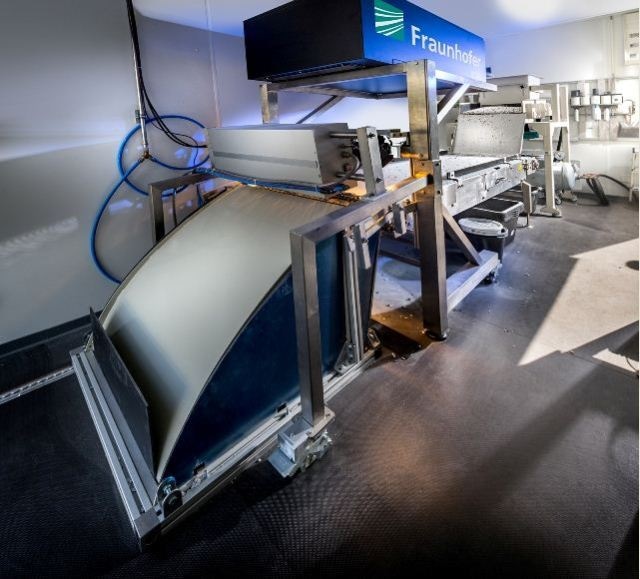Jun 1 2016
Recycling black plastics, such as those found in car instrument panels, used to be impossible because their absorption properties made them simply invisible to typical analysis systems. But Fraunhofer researchers have developed a new technology that can sort black plastics according to type – and at affordable prices.
 Sorting machine with conveyor belt, which transports the shredded plastic waste. © Photo Fraunhofer IOSB
Sorting machine with conveyor belt, which transports the shredded plastic waste. © Photo Fraunhofer IOSB
Shopping at the supermarket inevitably results in a trash bin overflowing with plastic refuse. Whether it’s juice, meat, fruit, or other food items, it’s all packaged in plastic. The quantities are enormous – Germany alone produces roughly 5.7 million tons of it each year. Although the majority of people conscientiously put these packaging into their yellow recycling bins, only about 42 percent of the waste gets “reincarnated” as diapers, fleece pullovers, stuffed animals, and the like. The rest is sent to waste incineration plants, where it is converted into energy. Black plastics in particular suffer this fate because it has thus far been impossible to sort them by material type. Conventional sorting systems operate specifically within the near-infrared range, which in general allows them to categorize plastics. But what works especially well for most plastics fails for black ones: the soot that gives them their dark color absorbs most of the signal, so the optical system cannot see these substances. At the same time, the need to recycle these dark plastics has become more urgent, because any efforts to meet the EU thresholds for car recycling programs will have to include black plastics.
A system that sorts black plastics now ready for mass production
Researchers at the Fraunhofer Institutes for High Frequency Physics and Radar Techniques FHR in Wachtberg, for Optronics, System Technologies and Image Exploitation IOSB in Karlsruhe, and for Intelligent Analysis and Information Systems IAIS in Sankt Augustin now offer a solution to this problem. “For the first time, we have developed an affordable sorting system that detects every plastic color, including black, both in real time and in large quantities. We call this system blackValue,” says Prof. Thomas Längle, department head at IOSB.
A radar camera lies at the core of the system, which works as follows: shredded plastic waste is deposited onto a conveyor belt. At the end of it, the plastic flakes fall off in a wide arc at a speed of two to three meters per second. The radar camera emits a beam of terahertz radiation, which is between infrared radiation and microwaves, through this stream of falling flakes. At the opposite end of the beam, the system analyzes how the individual particles have modified the radiation and then determines what kind of plastic it is based on the spectra received. Within 35 milliseconds, the system decides whether or not to knock the particle out of the plastic stream using a precisely aimed blast of air. To open the blower nozzles at the right time, a color camera provides additional information about the shape of the object.
Sorting with a 98 to 99 percent success rate – at an affordable price
“The higher the frequency used by the camera, the more precise the measurements – but greater precision comes at a higher price,” says Dirk Nüßler, business unit spokesman for production at FHR, as he describes the challenge. “Radar or THz line scan cameras, which are designed to take measurements at a belt speed of, say, three meters per second (almost 10 km/h), can easily cost up to a million euros. That’s too expensive for recycling centers, however, so we looked for a compromise between precision and affordability.” Sophisticated algorithms from IAIS help to find the right balance; they can detect even minute differences in the spectra. And because they’re self-learning, their precision keeps growing over time. The results speak for themselves: operating at 90 gigahertz, the camera satisfies the sorting requirement of 98 to 99 percent, while its price, which is in line with a hyperspectral camera, is a relative bargain.
Applications for the terahertz camera are by no means limited to recycling. “This development of ours is a key technology that is suitable for a number of applications, from steel rollers to food production,” states Nüßler. Recognizing the need to adapt the camera to different requirements, the researchers gave it a modular design. For instance, different frequency expansions can be mounted much like lenses would be. Expansions for 120 and 240 gigahertz are currently being developed. The camera is expected to be available to recycling centers in early 2017 and will be ready for the market at the end of that year. Researchers will be presenting a transportable belt sorter with camera at the World Conference for Non-Destructive Testing (WCNDT) in Munich, June 13-17, 2016 (Booth BO B88).